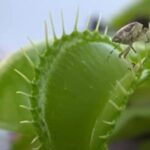As an Amazon Associate, this site earns commissions from qualifying purchases. For more details, click here.
Because of the way Venus flytraps catch prey, some have wondered if the plant has eyes that allow it to “see” its target. How can a plant without any brain or nervous system catch flies and other insects? The answer lies in its well developed sensors.
Venus flytraps do not have eyes, but they have hair triggers called sensory trichomes. When these sensors are set off by movement, pressure or touch, the trap is able to sense the presence of potential prey.
How Does a Venus Flytrap Detect Its Prey?
So while a Venus flytrap cannot see its environment, its sensors allow it to detect when a living organisms is in its trap. It can also distinguish between prey and other objects so the trap will not shut. To better understand this we have to look at how these carnivorous plants work.
A Venus flytrap can have 5 to 10 trap lobes or mouths at a time. Each half of the trap has two to three hair trigger sensors. The trap shuts if something sets off the sensors twice in 20 seconds.
An electric signal is generated when an object sets off one of the sensors. If the sensor is triggered again within 20 seconds, the trap will clamp down. Having these requirements is essential to prevent false alarms like a pebble or something it cannot eat (stones for example) dropping on the leaves.
The trap lobes also function as the mouth and digestive system of Venus flytraps, and with these sensors there is no need for eyes.
The sensors serve as the eyes of the plant. But the traps will not be able to do much unless it can lure the insects towards it.
To do this, Venus flytraps produce a scent to attract flies, spiders and other insects. The smell is akin to fruits which insects love, so it is no surprise they are lured into the trap. Once a bug lands in the lobes and steps on the triggers, the leaves close over them.
The sensors in a Venus flytrap are very sensitive to stimulation and work even at night. a slight movement by a potential prey will trigger the trap.
Once electrical signals are set off, they go through the plant rapidly. The upper portion of the trichomes serve to enhance the stimuli, spreading all over the lobes. All of these takes place in less than a second, testament to how well developed the Venus flytrap is.
Bottom line: Venus flytraps depend on the movement of prey to sense its presence. If you are feeding it non-live food such as the Omega One 3 Pack, you have to stimulate the sensors to get them to close. You can do this by tapping once or twice.
How Does a Venus Flytrap Know When to Shut Its Trap?
When an electrical signal goes off in a trap, charged atoms known as ions start moving in its cells. If another electrical signal is transmitted, hydrostatic pressure in the cells drop, causing the trap to shut.
So we have an idea of how a Venus flytrap closes. But how does the plant know when to close? The plant cannot see, but its calcium ions work just as well.
Calcium ions in a Venus flytrap increase when the hair triggers are set off by insects. This enables the plant to determine when to close its trap.
A study published in Nature Plants showed evidence that calcium ions in Venus flytraps helps it “know” when to shut a trap to capture a prey, or leave it open because the object is not edible.
The trap lobes of a Venus flytrap consist of two leaves with hair triggers at the end. The cells of each leaf has calcium ion, and the volume increases when an electrical signal goes off.
This increase in calcium ion drops off once the electrical signal stops. But if the signal is followed by another one in 20 or 30 seconds, the calcium ion levels increase and the trap closes.
Researchers had long believed that calcium ions were involved in the process. But it was only in 2020 when this study was conducted that scientists were able to verify it.
What this tells us is that even though Venus flytraps do not have eyes, their sensors are just as effective when it comes to capturing prey.
The study also revealed that a very slow moving animal like a snail could trigger the two electric signals. In other words, a single long touch might cause the flytrap to shut. Once the trap is closed, the next stage will begin, the digestion process.
How Does a Venus Flytrap Digest Insects?
Once a Venus flytrap catches an insect, it will close but not entirely. Very small bugs can escape and this is necessary so the flytrap does not waste energy on bugs with little to no nutritional value.
A large insect will have a harder time escaping as the trap gets tighter the more it struggles. The Venus flytrap will start releasing digestive enzymes to break down the bug, similar to how animals digest food.
Venus flytraps only consume the soft parts of a bug. After 5 to 12 days, the trap opens up so the rain can wash away the exoskeleton.
Aside from digestive enzymes, the plant also produces antiseptic fluids. This keeps bacteria off the bug and ensures it does not decay while being consumed.
This only works if the bug is completely inside the trap. If it is too large, the parts hanging out will rot and cause the trap to blacken and die. This is why it is important that you should only feed small insects to Venus flytraps. This also applies if you are feeding it Tetra Pro Fish Food or mealworms.
We know what happens when a Venus flytrap eats an insect, but scientists are still not sure how this works. These plants do not possess muscles, so they must have some other mechanism that allows the plant to digest bugs.
Venus flytraps can also eat freeze dried mealworms and fish food. Because these are not living things, you have to stimulate the trap to get it to close. After the trap shuts it will start digesting. No matter what a Venus flytrap eats, the process is the same as described here.
How a Venus Flytrap Can Sense Things
Venus flytraps are living beings, but not conscious and do not have a nervous system, so how are they able to sense when a prey is nearby? These plants can tell the difference between an edible bug and something inanimate like a rock, but how?
This is why people keep asking if Venus flytraps have eyes or brains, because they behave as if they do. Scientists are not entirely sure but they have a working theory.
As explained earlier, Venus flytraps are able to “count” and “remember” the number of times an object triggers the trap by way of calcium ions. When a trap is triggered, it sends an electrical signal through the plant, increasing calcium ion levels.
These levels will drop if the electrical signal is not repeated, and the trap will remain open. But if there is another one, the calcium ion levels go up again, and this is what allows Venus flytrap to count and recall.
According to researchers, proteins likely play a role in the delivery of these electrical signals. Studies have shown that proteins in Venus flytrap hair triggers are sensitive to electrical inputs.
This could indicate that these proteins play a part in helping the plant “see” and “sense” its environment. Obviously plants do not have nervous systems like animals, but they do possess a means of detecting what is happening in their traps.
The combination of these proteins, electrical signals and the hair triggers enable Venus flytraps to capture prey efficiently. A lot still needs to be learned about how these plants respond to stimuli, but what is clear is they do not need to see to help them find prey.
Conclusion
The way a Venus flytrap catches pretty is uncanny, and it all comes down to its sensors and proper stimuli. Even though the plant does not have eyes, a brain or nervous system, it is still an efficient predator due to its traps.

My fascination with carnivorous plants began many, many years ago with Venus Fly Traps. Now I am more than happy to impart what I know with other enthusiasts and those who are curious about meat eating plants.



